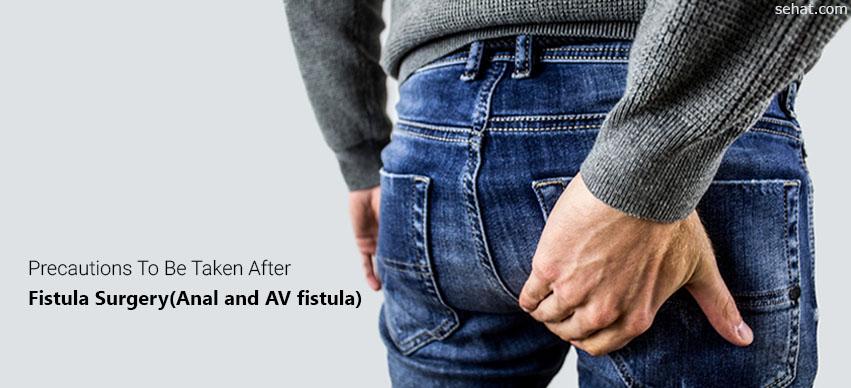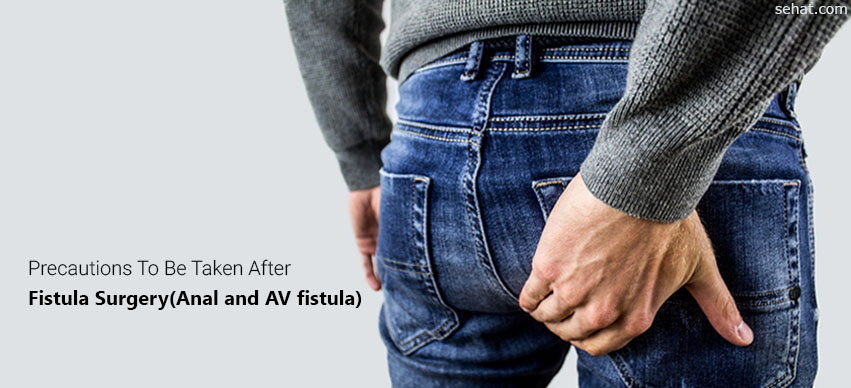
Recovering from a surgery can be physically and mentally demanding. This is because, although surgeries are a mode of treatment, they can often be traumatic. In order for recovery to be quick and uncomplicated, it is necessary to follow certain precautions after surgery.
What Is An Anal Fistula?
An anal fistula is a fairly common medical condition in which a tunnel or a tract is formed between the anal canal and outer skin of the anus. An anal fistula can be a troublesome condition since the faecal matter, pus or mucous which oozes out from the tract can soil clothes and beddings and may also irritate surrounding skin and tissues resulting in pain and inflammation.
Causes For The Formation Of An Anal Fistula Are
Rectal examination and rarely examination under anaesthesia may be required to diagnose this condition. Once diagnosed, fistulas are treated surgically
Precautions To Be Taken After Surgery For Anal Fistula
- Your surgical wound may take 1-4 weeks to heal. Healing is very variable. Recovery time is different for different individuals. Patients are not required to stay in the hospital for longer than 2 days.
- Your doctor will advise you have a sitz bath 2-3 times a day. For a sitz bath, a tub is filled with warm water with 2 teaspoons of Epsom salt or bleach. The patient is supposed to soak the perineum is water for 15-20 minutes. The perineum is then patted dry with a cotton cloth.
- The most important step to enable recovery is wound care. Keep the wound area clean and dry.
- Avoid wiping the wound area vigorously and excessively. This can irritate the skin due to friction. Baby wipes may be advised for the purpose of cleaning.
- Your doctor will advise you to pay regular visits for dressing. You also need to get the pack changed if the pack gets soaked.
- Along with proper wound care, make sure to take medications as prescribed by your doctor. On discharge, your doctor will prescribe you a set of medications including antibiotics, anti-inflammatory drugs and also laxatives.
- In recovering from an illness or surgery, diet and regimen greatly influence the healing process. The following dietary guidelines may be followed
- Patients can resume their regular activities provided they don’t indulge in work which requires a lot of training and lifting heavy objects.
- You need to call your doctor or surgeon immediately if you notice any of the following signs and symptoms
- Bleeding from the surgical wound site.
- Oozing of pus or foul-smelling discharge from dressing site
- Fever of 101 degrees Fahrenheit or higher
- Persistent nausea and vomiting
- Bloating and unable to pass motions and gas.
What Is AV Fistula?
AV fistula or an arteriovenous fistula is a surgically formed connection between an artery and a vein. AV fistulas provide access for hemodialysis (a process which removes waste such as urea, creatinine and excess water from the blood) in the treatment of patients with chronic renal failure.
Advantages Of Having An Arteriovenous Fistula Are
- Low infection rates as compared to those in graft surgeries.
- Does not require the use of any foreign materials or catheters
- They provide long-term access as compared to grafts
Precautions To Be Taken After Surgery For AV Fistula
Longevity of arteriovenous fistulas greatly depends upon post-operative care of the fistula. Certain precautions to be taken after an AV fistula surgery are:
- You may be required to stay in the hospital for up to 24 hours after surgery for the formation of AV fistula to monitor progress and its patency.
- Patients are asked to avoid overuse of the arm having a fistula.
- Avoid wearing tight clothing, wristbands or snugly-fitting watches around the arm having an AV fistula
- Protect the arm from direct trauma or injury as it can cause the fistula to rupture
- Keep checking regularly for “bruit†(this can be checked y a doctor or nurse by placing a stethoscope lightly over the fistula to listen to the flow of blood) and “thrill†(flow of blood through the fistula can be felt by palpating the fistula).
- Avoid using the hand for lifting heavy objects for at least 2 weeks after fistula surgery.
- Your doctor may advise you to carry out strengthening exercises for the arm having AV fistula. This can be done by squeezing a rubber ball 2-3 times in a day for up to 2-3 minutes.
- To keep the AV fistula patent for a long period of time, maintain cleanliness around the fistula after dialysis.
- Avoid falling asleep on the arm having a fistula.
- Avoid measuring blood pressure from the arm having an AV fistula.
- Whenever you pay a follow-up visit to your doctor’s clinic where you are asked to undergo blood tests, make sure to tell the nurse or technician to not apply a tourniquet or draw blood from the arm having AV fistula.
- You need to contact your doctor or surgeon immediately if you notice any of the following red flag signs and symptoms
- Bruising at the site of fistula
- Bleeding from a punctured site at fistula. This can create considerable blood loss.
- If you get a fever after surgery with a temperature higher than 100 degrees Fahrenheit. This can indicate the presence of infection.
- If you notice the absence of thrill at the site of fistula. This condition becomes an emergency as it suggests the formation of a thrombus/clot at the fistula site.
- If you notice tingling, numbness or weakness in the arm having a fistula. This occurs due to ischemic polyneuropathy or lack of blood supply to the remaining arm due to obstructed blood flow.
- If you notice breathlessness or difficulty in breathing with swelling over lower extremities. This is an emergency condition which indicates cardiac failure.
- Each surgery has its own pros and cons. Successful recovery after any kind of surgery largely depends upon the post-operative care provided to the patients and more importantly self-care in the form of appropriate precautions, adequate rest and a suitable diet and regimen.

